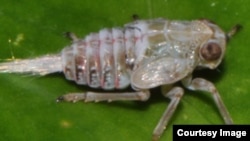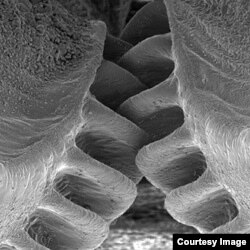If you think humans invented the kind of gears you find in an automobile transmission, think again.
Scientists have discovered that the humble Issus, a plant hopping insect the size of a flea, has “hind-leg joints with curved cog-like strips of opposing ‘teeth’ that intermesh, rotating like mechanical gears to synchronize the animal’s legs when it launches into a jump.”
It’s being called the “first observation of mechanical gearing in a biological structure,” according to scientists at the University of Cambridge in England where the discovery was made.
"We usually think of gears as something that we see in human designed machinery, but we've found that that is only because we didn't look hard enough,” said co-author Gregory Sutton, now at the University of Bristol. “These gears are not designed; they are evolved - representing high speed and precision machinery evolved for
synchronization in the animal world.”
The gears resemble what you’d find on a bicycle or in every automobile transmission, with each gear tooth having a rounded corner at the point it connects to the gear strip, which is a shock absorbing feature to keep the teeth from shearing off.
On the Issus, an insect common in European gardens, the opposing hind legs lock together like gears in a car, so that the legs move almost simultaneously--within one millionth of a second of each other.
Researchers said the design is critical for the powerful jumps the insect uses as its primary mode of transport.
The jumps are powerful indeed. The Issus accelerates to five meters per second within milliseconds and endures up to 700 g-forces, much more than the human body can withstand.
“This precise synchronization would be impossible to achieve through a nervous system, as neural impulses would take far too long for the extraordinarily tight coordination required,” said lead author Malcolm Burrows, a professor at Cambridge’s Department of Zoology. “By developing mechanical gears, the Issus can just send nerve signals to its muscles to produce roughly the same amount of force - then if one leg starts to propel the jump the gears will interlock, creating absolute synchronicity.”
Burrows added that the in the case of the Issus, the “skeleton is used to solve a complex problem that the brain and nervous system can’t.”
The gears are only found in the juvenile Issus, and scientists still don’t know why the hind-leg gears are lost in adulthood.
The findings are reported in the latest issue of the journal Science.
Here's a video on the discovery, which shows the insect jumping:
Scientists have discovered that the humble Issus, a plant hopping insect the size of a flea, has “hind-leg joints with curved cog-like strips of opposing ‘teeth’ that intermesh, rotating like mechanical gears to synchronize the animal’s legs when it launches into a jump.”
It’s being called the “first observation of mechanical gearing in a biological structure,” according to scientists at the University of Cambridge in England where the discovery was made.
"We usually think of gears as something that we see in human designed machinery, but we've found that that is only because we didn't look hard enough,” said co-author Gregory Sutton, now at the University of Bristol. “These gears are not designed; they are evolved - representing high speed and precision machinery evolved for
synchronization in the animal world.”
The gears resemble what you’d find on a bicycle or in every automobile transmission, with each gear tooth having a rounded corner at the point it connects to the gear strip, which is a shock absorbing feature to keep the teeth from shearing off.
On the Issus, an insect common in European gardens, the opposing hind legs lock together like gears in a car, so that the legs move almost simultaneously--within one millionth of a second of each other.
Researchers said the design is critical for the powerful jumps the insect uses as its primary mode of transport.
The jumps are powerful indeed. The Issus accelerates to five meters per second within milliseconds and endures up to 700 g-forces, much more than the human body can withstand.
“This precise synchronization would be impossible to achieve through a nervous system, as neural impulses would take far too long for the extraordinarily tight coordination required,” said lead author Malcolm Burrows, a professor at Cambridge’s Department of Zoology. “By developing mechanical gears, the Issus can just send nerve signals to its muscles to produce roughly the same amount of force - then if one leg starts to propel the jump the gears will interlock, creating absolute synchronicity.”
Burrows added that the in the case of the Issus, the “skeleton is used to solve a complex problem that the brain and nervous system can’t.”
The gears are only found in the juvenile Issus, and scientists still don’t know why the hind-leg gears are lost in adulthood.
The findings are reported in the latest issue of the journal Science.
Here's a video on the discovery, which shows the insect jumping:












